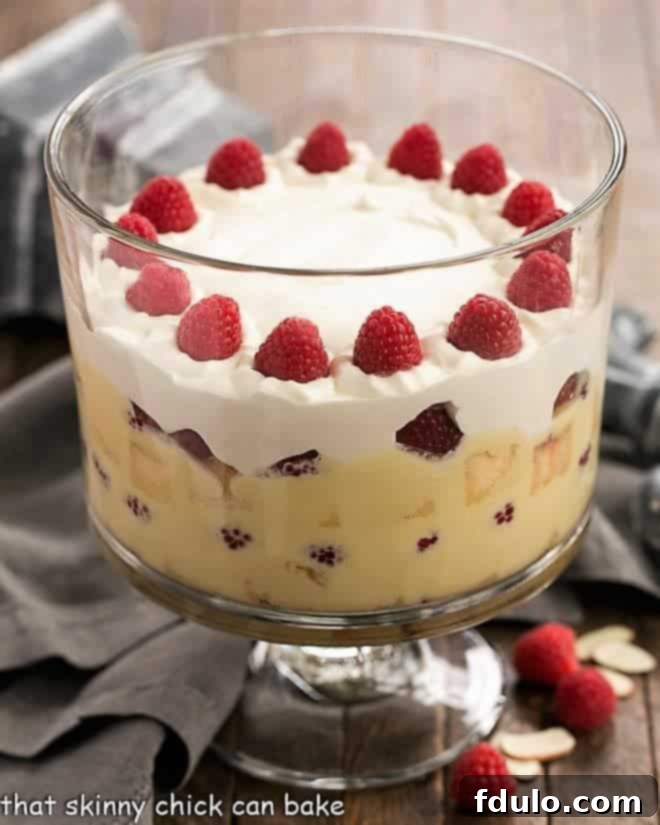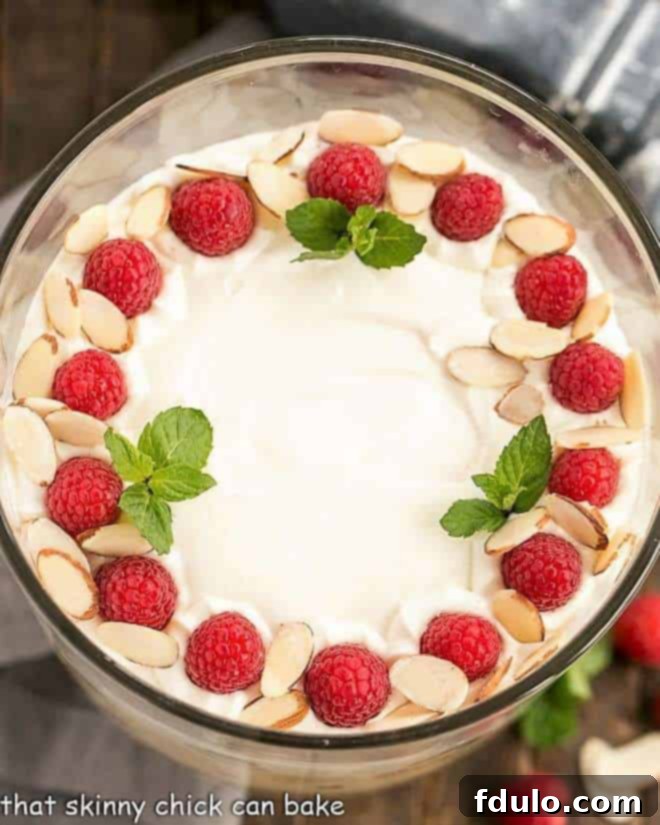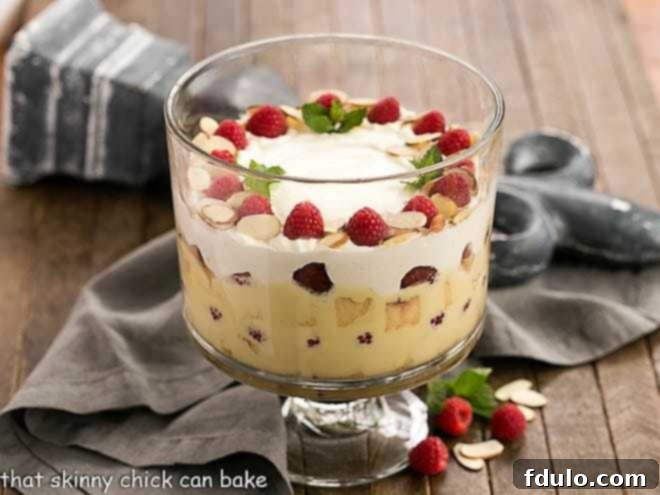Indulge in the sublime delight of a Traditional English Trifle, a classic layered dessert that brings joy to any occasion. My version, crafted with rich pound cake, a hint of Grand Marnier, luscious creme anglaise, fluffy whipped cream, and vibrant fresh berries, promises pure bliss in every spoonful. Decades ago, during my parents’ year in Scotland, I had my first encounter with this iconic British dessert. It was a simple yet unforgettable experience.
That cherished Scottish rendition featured light sponge cake, a generous douse of sherry, Bird’s Custard mix, freshly whipped cream, and sun-ripened raspberries picked from the garden. While many of my past Trifle Recipes have ventured into modern interpretations, for this particular creation, I returned to those fond memories, channeling the essence of that traditional Scottish trifle to craft a perfect Christmas Trifle.

Why This Traditional English Trifle is a Must-Make
Just last week, for a festive holiday luncheon, I presented this exquisite traditional English trifle to my friends, and it was met with enthusiastic applause. While I’ve explored various trifle creations in the past, such as the delectable Strawberry Cheesecake Trifle and the indulgent Fudgy Brownie Trifle with Chocolate Mousse, I felt compelled to revisit the authentic flavors I first encountered in the British Isles. The overwhelmingly positive reaction from my guests confirmed its resounding success. Here are compelling reasons why this Traditional English Trifle recipe should be at the top of your baking list:
- Stunning Presentation: Served in a beautiful glass trifle dish on a pedestal, the distinct layers of cake, fruit, custard, and cream create a visually arresting centerpiece that is sure to impress. It’s a feast for the eyes before it even reaches the palate.
- Harmony of Flavors and Textures: The ingenious combination of moist cake, silky smooth custard, delicate whipped cream, and bursts of fresh fruit creates a symphony of textures and tastes. Each spoonful offers a perfect balance of sweetness, creaminess, and refreshing fruitiness.
- Feeds a Crowd Effortlessly: This generous trifle recipe is designed to serve a large gathering, making it an ideal dessert for dinner parties, holiday celebrations, family reunions, or any event where you need to cater to many guests. It’s a crowd-pleaser that requires minimal last-minute fuss.
- A Taste of British Heritage: For those seeking an authentic taste of British culinary tradition, this trifle delivers. It embodies the essence of a classic English dessert, offering a comforting and nostalgic experience.
- Perfect for Holidays: With its vibrant colors and luxurious components, this trifle is particularly well-suited for holiday tables, especially as a stunning Christmas Trifle. The festive berries and rich cream evoke a sense of celebration.
Key Ingredient Notes for Your Perfect Trifle
Crafting the perfect English Trifle begins with selecting the right ingredients. While tradition offers a solid foundation, there’s always room for personal preference and smart shortcuts. Here’s a closer look at the components:
- Pound Cake: The foundation of our trifle. While traditional versions often feature light sponge cake or delicate ladyfingers, a store-bought pound cake (like a frozen Sara Lee, defrosted overnight in the refrigerator) offers a fantastic shortcut without compromising on flavor or texture. Its dense yet tender crumb absorbs the liqueur beautifully.
- Grand Marnier: This orange-flavored liqueur is used to lightly douse the cake, infusing it with a delicate citrus aroma and a touch of boozy warmth. Historically, sherry is the traditional choice for trifles, and it offers a more classic, nutty undertone. Feel free to experiment with either, or choose another complementary spirit like brandy or even a fruit liqueur.
- Seedless Raspberry Jelly or Jam: While American jelly (often a fruit spread for toast) or jam is commonly used for convenience and flavor, traditional British trifles often incorporate a layer of Jell-O (what Britons refer to as “jelly”). Using a good quality seedless raspberry jam ensures a smooth, intensely fruity layer that complements the fresh raspberries.
- Raspberries: Fresh, ripe raspberries are essential for their vibrant color, tangy flavor, and delicate texture. They cut through the richness of the cream and custard. Beyond raspberries, feel free to use other fresh fruits like strawberries, blueberries, or sliced peaches. Candied fruits, nuts, or chocolate shavings also make excellent garnishes.
- Heavy Cream, Whipped: A generous layer of freshly whipped heavy cream is a non-negotiable component of any authentic trifle. Sweetened lightly with powdered sugar and a hint of vanilla, it provides an ethereal, cloud-like topping that beautifully balances the other rich layers. Ensure your cream is very cold for best whipping results.
- Custard (Creme Anglaise): This is the creamy heart of the trifle. You can prepare it from scratch, creating a silky-smooth creme anglaise with egg yolks, sugar, and cream, or opt for a convenient box mix. Unlike thicker American puddings, traditional British custard is typically thinner, more akin to a pouring sauce. This allows it to seep slightly into the cake layers, adding to the trifle’s moistness.

Expert Tips for Crafting a Flawless English Trifle
The true magic of a Traditional English Trifle lies in its artful layering. Carefully composing each component is what elevates this dessert from simple ingredients to a stunning culinary masterpiece. Here are invaluable tips for creating a beautiful and delicious Christmas Trifle or any trifle for that matter:
- Master the Art of Layering: Precision is key. You need to carefully layer each component to maintain distinct, attractive strata. If you smear the sides of your glass trifle bowl with custard or jam, the visual impact will be diminished. It’s always easier to prevent a drip or smudge than to painstakingly clean it up later – though even experienced bakers find themselves tidying up now and then!
- The Cake Base is Crucial: Begin with a solid foundation of cake. Cut your pound cake into bite-sized cubes for effortless serving and eating. If incorporating jam, spread a thin layer on half of your cake pieces before arranging them, or simply dot spoonfuls across the surface of the cake layer. Choose a jam flavor that harmonizes with your chosen fruit, such as raspberry jam for fresh raspberries.
- PRO-Tip: Traditional “Jelly” vs. American Jam/Jelly: It’s important to distinguish between traditional British “jelly” (which refers to Jell-O or gelatin) and American jelly (fruit spread) or jam. While many modern trifles use fruit jam for convenience, an authentic English trifle often features a layer of set fruit-flavored gelatin. If you’re seeking a truly traditional experience, consider exploring this “jelly” option for an added textural dimension.
- Drizzle with Delightful Spirits: Lightly douse the cake with the alcohol of your choice. This step is entirely optional but highly recommended, as the cake absorbs the flavors and softens beautifully. Select a liqueur that complements your trifle’s overall profile.
- PRO-Tip: Alcohol Choices: Cream sherry is the classic and most traditional choice for trifles, offering a rich, sweet, and nutty depth. However, many other delightful liqueurs work wonderfully, such as Grand Marnier for a citrusy note, brandy for warmth, or even a fruit liqueur. If you prefer an alcohol-free version, orange juice or a fruit syrup makes an excellent substitute, providing moisture and flavor without the spirits.
- Introduce the Creamy Layer: Next comes the “pudding” layer, which can be homemade custard, a delicate creme anglaise, or a convenient pudding made from a box mix. Remember that creme anglaise is typically thinner, more like a pouring sauce. When adding it, aim for the center of the bowl to minimize spillage and ensure the distinct layers remain visible through the sides of your trifle bowl.
- PRO-Tip: British Custard Shortcut: Bird’s Custard Powder (affiliate link) is a staple in Britain and readily available in international aisles of many supermarkets, offering a quick and authentic shortcut. Boxed pudding mixes are also viable alternatives in the US.
- Alternative Custard Shortcut: Dorie Greenspan famously uses melted vanilla ice cream as a shortcut for creme anglaise, providing a rich, creamy, and easy alternative to consider.
- Layer Repetition and Garnishing: There are no strict rules for the number of layers or their precise order. Add a layer of freshly whipped cream, and then feel free to repeat the cake, fruit, and custard layers. I often find that adding whipped cream only to the very top, after repeating the other layers once, creates a lovely visual contrast.
- The Finishing Touch: Garnish Generously: Elevate your trifle’s appeal by garnishing the top with more fresh fruit, candied fruit, toasted nuts, or whatever ingredients reflect your fillings. For a truly festive touch, especially for a Christmas Trifle, a vibrant array of red berries (like raspberries or cranberries) and fresh mint leaves creates a stunning and seasonal presentation.
- Chill for Perfection: Once assembled, allow your trifle to chill in the refrigerator for at least a few hours (preferably overnight) before serving. This crucial step allows the flavors to meld beautifully and the cake to fully absorb the liqueurs and moisture from the custard, resulting in a more cohesive and delicious dessert.

Frequently Asked Questions About English Trifle
At its heart, a Traditional English Trifle is a delightful layered dessert consisting of several key components: a base of sponge cake or ladyfingers, often soaked in sherry or other spirits; a layer of fruit (traditionally fresh or preserved raspberries); a spread of fruit jam (or British “jelly,” which is gelatin); a rich, creamy custard; and a generous topping of freshly whipped cream. It’s often garnished with additional fruit, nuts, or grated chocolate for a final flourish. The beauty lies in the interplay of these distinct layers.
The most common and visually appealing way to serve a trifle is in a specialized trifle bowl or any large glass bowl. The transparent sides beautifully showcase the intricate layers, making it a stunning centerpiece for any table. To achieve the most elegant presentation, aim for even, distinct layers. For individual servings, clear glasses with relatively wide openings can be used to create charming individual desserts. While it might be a little trickier to prevent smudges on the sides of smaller containers, the delight of having one’s own perfectly portioned dessert is well worth the effort!
Absolutely, making a trifle the day before serving is highly recommended! This allows ample time for the cake layers to thoroughly absorb the liqueurs and fruit juices, resulting in a more moist, flavorful, and cohesive dessert. The only component you should consider adding just before serving is the final layer of whipped cream, as it can sometimes separate or lose its peak over extended periods in the refrigerator. Since the custard contains eggs, it’s crucial to keep your partially or fully assembled trifle refrigerated until it’s time to enjoy.
The delightful name “trifle” originates from the Old French word “trufle,” which literally translates to “something whimsical or of little importance.” This humble name belies the dessert’s often elaborate and festive appearance. Perhaps it refers to the seemingly simple act of layering various sweet ingredients, or perhaps it highlights the lighthearted, celebratory nature of such a treat. Regardless of its etymological roots, a dessert composed of cake, spirits, jam, rich custard, and fresh fruit certainly lives up to the definition of something whimsical and utterly enjoyable.
Whipping cream to perfection is simpler than you might think! Modern heavy cream and whipping cream, especially ultra-pasteurized varieties, are much more forgiving and almost impossible to overwhip compared to those from years past. The primary goal is a light, airy, yet stable consistency. My top tip is to place the bowl you intend to use (preferably a metal one) in the freezer for about 15 minutes before you begin. PRO-Tip: A well-chilled bowl helps keep the fat in the cream cold, which is essential for achieving a light, fluffy, and stable whipped cream that holds its shape beautifully.
Once your bowl is chilled, pour in the very cold heavy cream. If desired, add powdered sugar for sweetness and a touch of vanilla extract for flavor. Using an electric mixer (handheld or stand mixer with a whisk attachment), start on medium speed and gradually increase to high. Beat just until stiff peaks form. Stiff peaks mean that when you lift the beaters or whisk from the cream, the peaks stand straight up without collapsing. Avoid over-beating, which can turn the cream grainy or even into butter. Freshly whipped cream adds an unparalleled elegance to your trifle.
A Glimpse into the History of English Trifle
The English trifle boasts a rich and fascinating history, with its origins tracing back to the 16th century. The earliest recorded recipe, found in “The Good Huswifes Jewell” by Thomas Dawson in 1596, was a much simpler affair, consisting primarily of a thick cream flavored with sugar, ginger, and rosewater. Over the centuries, the trifle evolved, with the addition of alcohol-soaked bread or cake, custard, and fruit becoming standard. By the 18th century, the classic layered structure we recognize today had largely taken shape, solidifying its place as a beloved dessert in British households and at celebratory gatherings. It’s a dessert that has adapted through time, yet consistently offered comfort and luxury, making it a timeless culinary treasure.
You May Also Like: Explore More Holiday Dessert Recipes
If you loved creating this Traditional English Trifle, you’ll surely enjoy exploring other delightful recipes perfect for the holidays and beyond. Expand your baking repertoire with these festive and mouth-watering treats:
- Christmas Wreath Cookies from Real Housemoms – Adorably festive and fun to decorate!
- Buche de Noel – A classic chocolate yule log that’s as impressive to look at as it is delicious to eat. The ultimate Christmas cake!
- 30+ Christmas Cookies – A comprehensive collection perfect for holiday gifting, leaving for Santa, or stocking your holiday buffet. Try not to eat them all first!
- Chocolate Mousse Cake with Lady Fingers – A luscious, no-bake dessert that’s rich and elegant.
- Strawberry Cheesecake Trifle – Another marvelous trifle recipe, this one featuring light angel food cake and creamy cheesecake flavors.
- Toffee Noel Nutballs – Small, buttery, and utterly irresistible holiday treats.
- Cranberry Cheesecake Trifle – A festive and tangy variation perfect for the colder months.
- Chewy Ginger Snap Cookies – Spicy, sweet, and perfectly chewy, a holiday classic.
- More Holiday Recipes – Discover a treasure trove of recipes for ALL holidays, including Christmas, Easter, Thanksgiving, 4th of July, and many more!
Stay in touch through social media! Find me @ Instagram, Facebook, and Pinterest. Don’t forget to tag me when you try one of my recipes! And if you love the results, please give it a 5-star rating in the recipe card below.

Traditional English Trifle
45 minutes
10 minutes
55 minutes
12-16 servings
A classic holiday trifle with raspberries, pound cake, creme anglaise and whipped cream!
Ingredients
- 10 ounces pound cake (I used a Sara Lee frozen pound cake)
- ½ cup seedless raspberry jam
- 12 ounces fresh raspberries (reserve a few to garnish the top of your trifle)
- 2 cups heavy cream
- ½ cup sugar
- 6 egg yolks
- 1 teaspoon vanilla
- 2 tablespoons Grand Marnier (or add a bit more if you want more boozy flavor!)
- 1 ¼ cups heavy cream
- ¼ cup powdered sugar
- ½ teaspoon vanilla
- Sliced almonds to garnish, if desired
Instructions
- Cut the pound cake into bite-sized cubes. Spread some jam on half the cubes and place them in the bottom of a trifle dish. Spread jam on the rest of the cake and set aside.
- Sprinkle half the Grand Marnier, then half the raspberries over the cake layer.
- Make creme anglaise by heating the 2 cups of cream in a medium saucepan over medium heat. Beat together the egg yolks with the sugar until thick and pale yellow. Set aside.
- Just before the cream starts to boil, remove from the heat. Very slowly drizzle some of the hot cream into the sugar/yolk mixture while beating or whisking constantly.
- Return the mixture to the pan and cook over low until the mixture thickens and can coat a spoon. Add the vanilla.
- Do not allow to boil for the smoothest texture. Run through a strainer if desired. Allow to cool before adding to the trifle.
- When the creme anglaise is cooled, pour about half in the middle of the trifle, then layer more cake, sprinkle with the rest of the Grand Marnier and raspberries, then the rest of the creme anglaise.
- Whip the 1 ¼ cups of heavy cream with the powdered sugar and vanilla until soft peaks form. Smooth whipped cream over the top of the trifle and garnish with raspberries and almonds if desired.
Notes
Inspired by English Trifle to Die For on allrecipes.com
Recommended Products
As an Amazon Associate and member of other affiliate programs, I earn from qualifying purchases.
- Egg separator
- European Trifle Bowl with Pedestal
- KitchenAid 9-Speed Digital Hand Mixer
Nutrition Information:
Yield:
16
Serving Size:
1
Amount Per Serving:
Calories: 352
Total Fat: 25g
Saturated Fat: 13g
Trans Fat: 1g
Unsaturated Fat: 10g
Cholesterol: 135mg
Sodium: 87mg
Carbohydrates: 30g
Fiber: 2g
Sugar: 21g
Protein: 5g
HOW MUCH DID YOU LOVE THIS RECIPE?
Please leave a comment on the blog or share a photo on Pinterest
